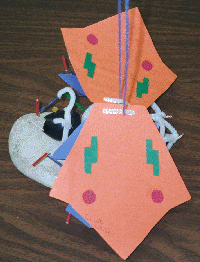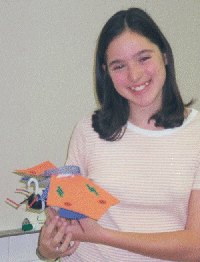I've got
that geometry bug!
A
Day In The Life of My Geometry Bug
 My
three dimensional imaginary insect is named the Poisonous Tree Septa-Insect. A
typical day in the life of my imaginary bug would be quite interesting. It
would awake in the morning in its grass bed on a high branch in a tree. Then,
it would go searching for food. The septa-insect would most likely eat some
bark or some leaves near its bed. After eating, my insect would leave it's tree
and go down to the ground. While there, the septa-insect may go searching for
grasses for its bed. In case it encountered any predators, it would use one of
its many defense mechanisms. For example, the two back points of the abdomen
are used to inject poison. Don't worry, the poison is too weak to harm humans.
Also, it has spots on its wings that look like eyes. The septa-insect's wings
could also provide it with an escape. Not to mention, it's strong legs could
give it quite a push off. After its time on the ground, it would most likely
fly to a flower field and pollinate some flowers there. Then, back in its tree
home it would sleep for a few hours. When it awakes again for the second time,
the septa-insect would eat again. The meal would probably include bark or
leaves again. At a certain point in its life, the insect would need to
reproduce. During mating time, the males try to impress the females. After the
insects all have mates and reproduce, their litters are about 20 to 25. The
reason the litter is so large is because many of the young babies are killed
right after birth. The particular geometry directly influences the everyday
life of the septa-insect.
My
three dimensional imaginary insect is named the Poisonous Tree Septa-Insect. A
typical day in the life of my imaginary bug would be quite interesting. It
would awake in the morning in its grass bed on a high branch in a tree. Then,
it would go searching for food. The septa-insect would most likely eat some
bark or some leaves near its bed. After eating, my insect would leave it's tree
and go down to the ground. While there, the septa-insect may go searching for
grasses for its bed. In case it encountered any predators, it would use one of
its many defense mechanisms. For example, the two back points of the abdomen
are used to inject poison. Don't worry, the poison is too weak to harm humans.
Also, it has spots on its wings that look like eyes. The septa-insect's wings
could also provide it with an escape. Not to mention, it's strong legs could
give it quite a push off. After its time on the ground, it would most likely
fly to a flower field and pollinate some flowers there. Then, back in its tree
home it would sleep for a few hours. When it awakes again for the second time,
the septa-insect would eat again. The meal would probably include bark or
leaves again. At a certain point in its life, the insect would need to
reproduce. During mating time, the males try to impress the females. After the
insects all have mates and reproduce, their litters are about 20 to 25. The
reason the litter is so large is because many of the young babies are killed
right after birth. The particular geometry directly influences the everyday
life of the septa-insect.
Since my bug can fly and it has such strong
legs for jumping high in the air, it usually dwells high in trees. It lives
only in deciduous trees such as Maples, Birches, or Gingkos. Being a relatively
small insect, it consumes the bark and the leaves of the tree it lives in.
However, it also pollinates flowers as a source of food. When it is on the
ground it will also eat grasses and other small vegetation growing on the
ground. However it doesn't eat other insects because its mouth parts are not
strong or sharp enough to chew bug flesh. It's mouth parts are short and
strong, somewhat like teeth to grind leaves, grasses, and bark. It walks on its
long legs, rather than crawling on shorter legs like other insects do. Its
wings are attached to the middle of the thorax, and it has two pairs of them.
The wings are broad and light, allowing the septa-insect to glide in the air after
it has taken flight. Where the septa-insect lives and what it eats are the two
main factors that make it such an interesting bug.
I made each set of wings a different
geometric shape. The larger set of wings on the top are septagons. I made them
by drawing a four sided diamond, and putting two rectangles on the two opposite
sides of the diamond. Once I had cut two of these shapes out of thin cardboard,
I glued paper on top of them. I also glued two red circles on each large wing
for a defense mechanism. This way, other predators may see these two spots and
think that they are eyes of a larger predator. This is called mimicry. The
smaller pair of wings underneath are decagons, or ten-sided polygons. I made
then by first creating a trapezoid. Then, I drew a hexagon and attatched it to
the base of the trapezoid. Once again, I cut two of those out of cardboard and
glued constuction paper to them. I then used white pipe cleaners to attatch the
wings to the thorax. I chose to use a white Styrofoam ball so it would be easy
to attach the wings. I also glued colorful beads in a band around the thorax,
because some poisonous insects are colorful to alert their predators of their
poison.
For the other body sections of my insect I
used various materials with different ideas. First of all, the head is made out
of rubber, and is a three dimensional parabola shape. For the eyes, I used
multi-sided yellow beads to represent the compound eyes. Some other insects,
such as flies also have this type of eye structure to see many different images
at once. I used a Styrofoam ball for the thorax, and pipe cleaners for the
abdomen. To create the abdomen, I took pipe cleaners and made a polyhedron. I
first started off with a pentagon, and then added other pentagons in various
places onto the first one. For the six legs, I used a wooden stick and made
three major leg parts, the femur (green), the tibia, (blue) and the tarsus
(red). The femur is the stronger of the two, because it helps the insect to
push off.
 The
septa-insect is very important to its ecosystem. Like many other insects, it
pollinates flowers. It has developed a special mouthpiece to do this. The
mouthpiece is a long, thin, one with a little hook on the end. The pollination
is very important to the flower species because it helps them reproduce and
spread their seeds. Not to mention, it provides another food source for the
insect. In conclusion, the Poisonous Tree Septa-insect is a complex bodied,
well adapted, interesting bug that would be quite interesting if it actually
existed.
The
septa-insect is very important to its ecosystem. Like many other insects, it
pollinates flowers. It has developed a special mouthpiece to do this. The
mouthpiece is a long, thin, one with a little hook on the end. The pollination
is very important to the flower species because it helps them reproduce and
spread their seeds. Not to mention, it provides another food source for the
insect. In conclusion, the Poisonous Tree Septa-insect is a complex bodied,
well adapted, interesting bug that would be quite interesting if it actually
existed.
Bibliography
1.) The World Book Encyclopedia, World Book
Inc. Copyright 1998. Pgs. 278-301
2.) New Standard Encyclopedia, Standard
Educational Corporation. Pgs. 336-338 and Pg. 211
3.) Websites used:
a) http://mathleague.com/help/geometry/polygons.html
b) http://coolmath.com/interior.html
c)
http://bhs-ms.org/geometry/bugs/geobugs.html
d)
http://gnv.ifas.ufl.edu/~tjw/recbk.html
e) http://insect-world.com/
f) http://biology.st-and.ac.uk/sites/jumping/
Project
Description
Research Questions
Student Work
|